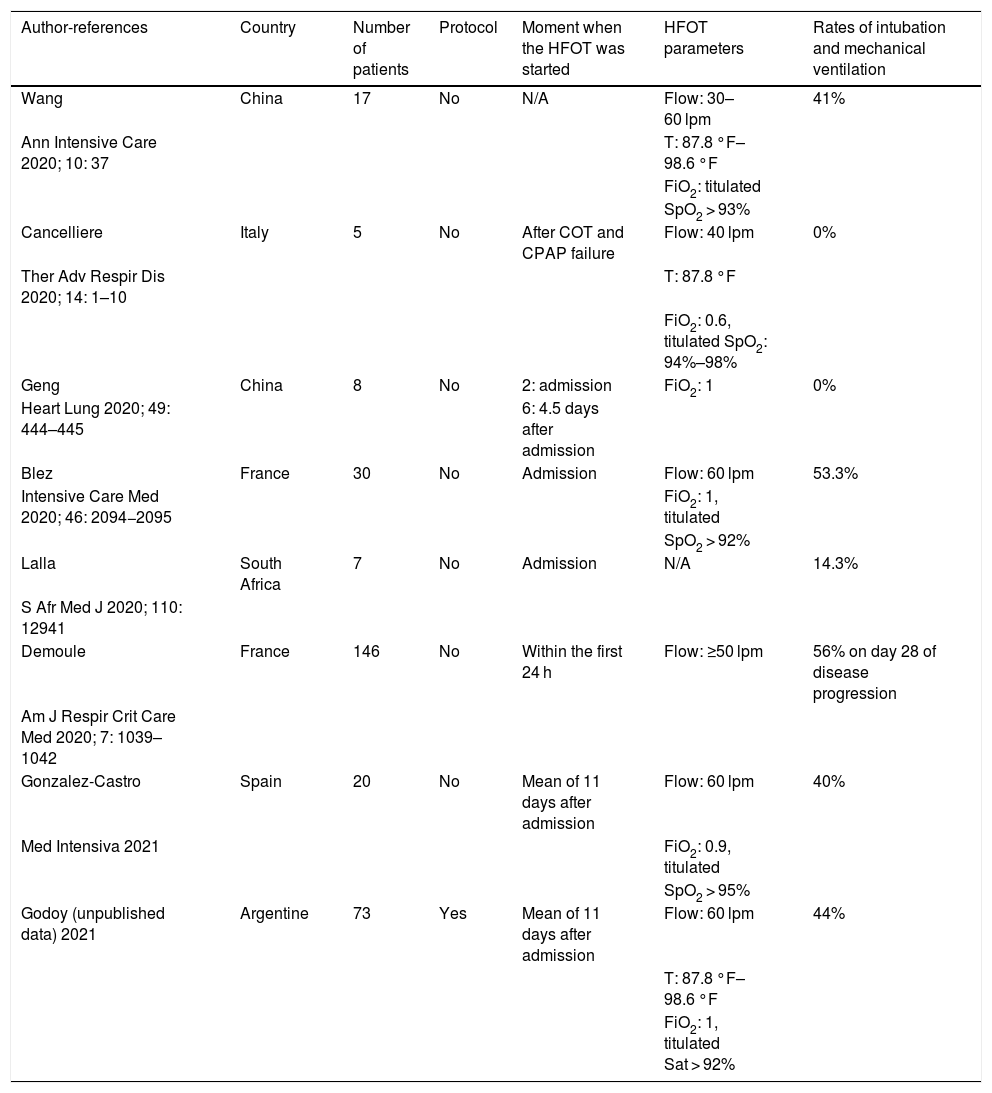We have been reading with great interest the scientific letter written by González-Castro et al. concluding that high-flow oxygen therapy (HFOT) is not an effective therapy, in clinical or economic terms, to treat acute hypoxemic respiratory failure due to SARS-CoV-2-induced pneumonia.1 As far as we know, statements like this should be taken with caution due to the limitations of the analysis.
Oxygen therapy is one of the main pillars for the management of this particular entity. To this date, multiple techniques have become available including the use of high-flow nasal cannulae (HFNC) that also optimize the conditions of the gas administered (temperature, humidity) with a more reliable FiO2.2 Physiologically speaking, it offers some attractive advantages and is very well-tolerated.2 Additionally, HFOT is versatile and can be used in the emergency room or in general rooms. This is an important advantage especially when the resources or beds available at the intensive care unit setting are scarce. Different consensus documents and clinical practice guidelines from various scientific societies advocate for the use of HFOT.3,4 Some controversial issues here are the risk of aerosolization and its impact on the rates of intubation and mortality.2
A meta-analysis conducted before the pandemic confirmed that HFOT reduces the need for increasing ventilatory support including invasive mechanical ventilation.5 However, uncertainty surrounds COVID-19-induced pneumonia due to the heterogeneity of the studies conducted on several aspects reported. Therefore, no valid conclusions can be drawn to this date on this regard (Table 1).
Series that used HFOT (without the prone positioning) to treat COVID-19-induced pneumonia. One study (published in Chinese) and case reports were excluded.
| Author-references | Country | Number of patients | Protocol | Moment when the HFOT was started | HFOT parameters | Rates of intubation and mechanical ventilation |
|---|---|---|---|---|---|---|
| Wang | China | 17 | No | N/A | Flow: 30–60 lpm | 41% |
| Ann Intensive Care 2020; 10: 37 | T: 87.8 °F–98.6 °F | |||||
| FiO2: titulated | ||||||
| SpO2 > 93% | ||||||
| Cancelliere | Italy | 5 | No | After COT and CPAP failure | Flow: 40 lpm | 0% |
| Ther Adv Respir Dis 2020; 14: 1–10 | T: 87.8 °F | |||||
| FiO2: 0.6, titulated SpO2: 94%–98% | ||||||
| Geng | China | 8 | No | 2: admission | FiO2: 1 | 0% |
| Heart Lung 2020; 49: 444–445 | 6: 4.5 days after admission | |||||
| Blez | France | 30 | No | Admission | Flow: 60 lpm | 53.3% |
| Intensive Care Med 2020; 46: 2094−2095 | FiO2: 1, titulated | |||||
| SpO2 > 92% | ||||||
| Lalla | South Africa | 7 | No | Admission | N/A | 14.3% |
| S Afr Med J 2020; 110: 12941 | ||||||
| Demoule | France | 146 | No | Within the first 24 h | Flow: ≥50 lpm | 56% on day 28 of disease progression |
| Am J Respir Crit Care Med 2020; 7: 1039–1042 | ||||||
| Gonzalez-Castro | Spain | 20 | No | Mean of 11 days after admission | Flow: 60 lpm | 40% |
| Med Intensiva 2021 | FiO2: 0.9, titulated | |||||
| SpO2 > 95% | ||||||
| Godoy (unpublished data) 2021 | Argentine | 73 | Yes | Mean of 11 days after admission | Flow: 60 lpm | 44% |
| T: 87.8 °F–98.6 °F | ||||||
| FiO2: 1, titulated Sat > 92% |
COT, conventional oxygen therapy; CPAP, continuous positive airway pressure; FiO2, fraction of inspired oxygen; HFOT, high-flow oxygen therapy; lpm, liters per minute; N/A, non-applicable; SpO2, oxygen saturation; T, temperature.
Therefore, the retrospective nature of the study and its small sample do not let us draw any conclusive statements yet. However, we should reflect on the data provided from a different angle. Only 20 patients (30% of the population) received HFOT. A total of 12 of these patients (60%) did not need to be escalated to ventilatory support and had shorter ICU and hospital stays. Also, no deaths were reported. No information on cost-effectiveness in this population has been disclosed. In our opinion, this situation cannot be considered a failure whatsoever.
On the other hand, when patients who remained «unresponsive and required invasive ventilation» were studied, the HFOT was implemented with further delay, they were older patients with more comorbidities, and worse oxygenation indices prior to the indication for HFOT, which makes us wonder:
- 1.
Would an earlier implementation of HFOT increase its effectiveness?
- 2.
Does HFOT affect all patients the same way or is it more beneficial for certain subgroups of patients?
- 3.
Does awake prone positioning plus HFOT increase the effectiveness of this oxygenation technique?
On the other hand, the protocols of initiation and withdrawal of HFOT are heterogeneous across the world, but they have not been universally validated yet. Our preliminary experience (data still unpublished) in 2 regions and in different countries is encouraging, especially regarding the association between HFOT and the awake prone positioning through the implementation of clinical guidelines or protocols since hospital admission. For all these reasons, we believe it is important to conduct well-designed studies to shed light on all these issues.
Please cite this article as: Godoy DA, Graneros N, Oyarzabal L, Murillo-Cabezas F. Oxigenoterapia de alto flujo en insuficiencia respiratoria aguda hipoxémica secundaria a neumonía por COVID-19. Med Intensiva. 2021;45:506–508.






